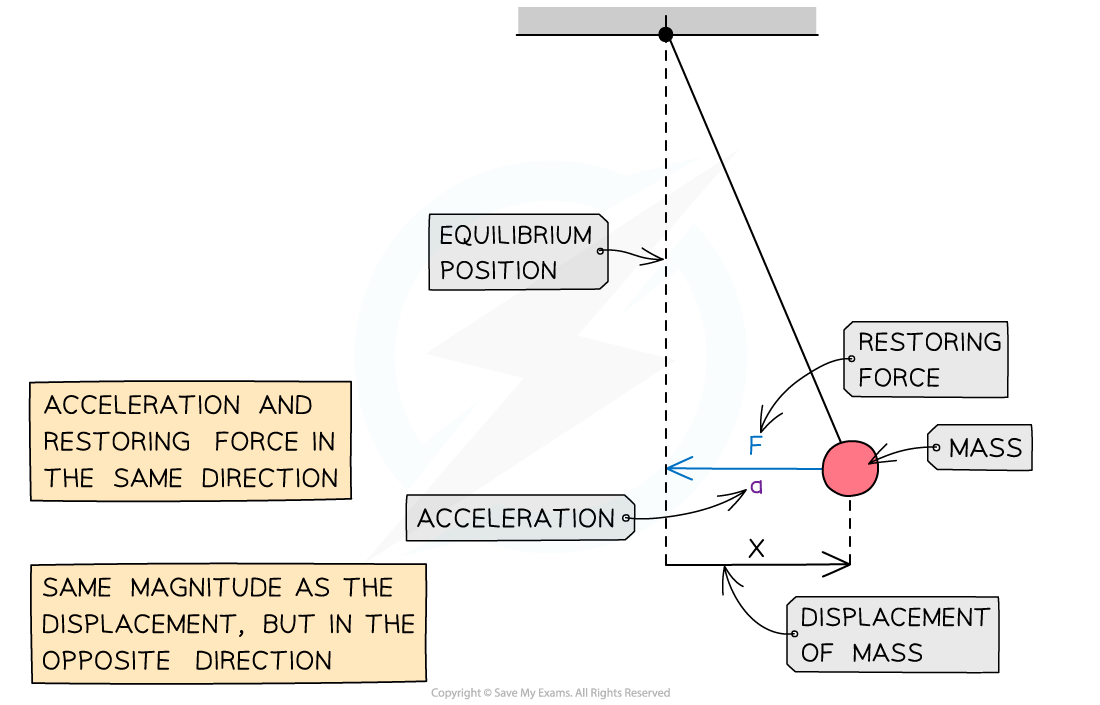Conditions for Simple Harmonic Motion
- Simple harmonic motion (SHM) is a specific type of oscillation where:
-
There is repetitive movement back and forth through an equilibrium, or central, position, so the maximum horizontal or vertical displacement on one side of this position is equal to the maximum horizontal or vertical displacement on the other
-
The time interval of each complete vibration is the same (periodic)
-
The force responsible for the motion (restoring force) is always directed horizontally or vertically towards the equilibrium position and is directly proportional to the distance from it
-
Examples of SHM
- Examples of oscillators that undergo SHM are:
- The pendulum of a clock
- A child on a swing
- The vibrations of a bowl
- A bungee jumper reaching the bottom of his fall
- A mass on a spring
- Guitar strings vibrating
- A ruler vibrating off the end of a table
- The electrons in alternating current flowing through a wire
- The movement of a swing bridge when someone crosses
- A marble dropped into a bowl

Examples of objects that undergo SHM
Modelling SHM
- Not all oscillations are as simple as SHM
- This is a particularly simple kind
- It is relatively easy to analyse mathematically
- Many other types of oscillatory motion can be broken down into a combination of SHMs
- An oscillation is defined to be SHM when:
- The acceleration is proportional to the horizontal or vertical displacement
- The acceleration is in the opposite direction to the displacement (directed towards the equilibrium position)
- The time period of oscillation is independent of the amplitude of the oscillation, for small angles of oscillation
- So, for acceleration a and horizontal displacement x
a ∝ −x
- You will be required to perform calculations on and explain two models of simple harmonic motion:
- A simple pendulum oscillating from side to side attached to a fixed point above
- A mass-spring system oscillating vertically up and down or horizontally back and forth

Force, acceleration and displacement of a simple pendulum in SHM
An Example of not SHM
- A person jumping on a trampoline is not an example of simple harmonic motion because:
- The restoring force on the person is not proportional to their displacement from the equilibrium position and always acts down
- When the person is not in contact with the trampoline, the restoring force is equal to their weight, which is constant
- This does not change, even if they jump higher

The restoring force of the person bouncing is equal to their weight and always acts downwards
Worked example
Explain why a person jumping on a trampoline is not an example of simple harmonic motion.
Answer:
Step 1: Recall the conditions for simple harmonic motion
- The conditions required for SHM:
- The restoring force/acceleration is proportional to the displacement
- The restoring force/acceleration is in the opposite direction to the displacement
Step 2: Consider the forces in the scenario given
- When the person is not in contact with the trampoline, the restoring force is equal to their weight, which is constant
- The value of their weight does not change, even if they jump higher (increase displacement)
Step 3: Write a concluding sentence
- The restoring force on the person is not proportional to their distance from the equilibrium position, therefore, this scenario does not fulfil the conditions for SHM







